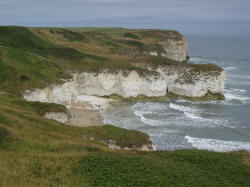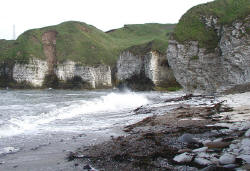|
2
Lighthouses
Flamborough has two lighthouses, one very
old and one not quite so old. They are about 300 metres apart. Charles
II gave Sir John Clayton permission to build the first one and it was
constructed in 1674, but he went bankrupt before it was lit.
The
second lighthouse was built in 1806 and extended to make it taller
in 1925.
The later tower is by the car park, and acts as a waypoint for deep sea vessels and coastal traffic, as well
as marking the Flamborough Headland for vessels heading for the ports of
Scarborough and Bridlington. A fog warning station is near
the cliff top.
The current lighthouse, by architect
Samuel Wyatt, was built by John Matson of Bridlington in 1806 at a cost
of £8,000. It was first lit on 1st December 1806.
The original lighting equipment was
designed by George Robinson and consisted of a rotating vertical shaft
to which was fixed twenty one parabolic reflectors, seven on each of the
three sides of the frame. Red glass covered reflectors on each side,
giving for the first time in lighthouse characteristics, two white
flashes followed by one red flash. This was an innovation quickly
adopted elsewhere. The lighthouse was oil-burning, with an equivalent
candle power of 13,860.
In 1925 it was extended making it
taller, photos of it before the changes are shown in the old photos at
the bottom of this page.
In 1940 the Flamborough Lighthouse was
electrified and further modifications took place in 1974.
An electric fog signal was installed in
1975 replacing diaphone apparatus. In older times a rocket was
discharged every 5 minutes in foggy weather reaching an altitude of
about 600 feet.
Flamborough Lighthouse was automated in early 1996, the keepers leaving
on 8th May. The fog signal was refurbished and a standard fog
detector fitted. The lighthouse is now controlled and monitored from the
Trinity House Depot at Harwich in Essex.
Bempton Cliffs
Bempton Cliffs,


 is a RSPB bird reserve and is on the
north coast of Flamborough Head. There are Gannets, Kittiwakes and
Guillemots by the thousand, and quite a few puffins. The smell is a bit
strong for some. In past days the eggs were harvested off these cliffs.
The visitors centre shows a film on this.
is a RSPB bird reserve and is on the
north coast of Flamborough Head. There are Gannets, Kittiwakes and
Guillemots by the thousand, and quite a few puffins. The smell is a bit
strong for some. In past days the eggs were harvested off these cliffs.
The visitors centre shows a film on this.
See our guide to
Bempton Cliffs.

So where does the name come from
The name Flamborough was first thought
to be derived from it being the place of the flame, but in the Domesday
Book the word is spelt "Flaneberg", possibly from the Saxon "Flaen"
meaning a dart, which the shape of the headland resembles.
 
 Photo
Malcolm Street
Photo
Malcolm Street

 
 Photo
Paul
Glazzard
Photo
Paul
Glazzard

 
 Photo by
John
Firth
Photo by
John
Firth
 |